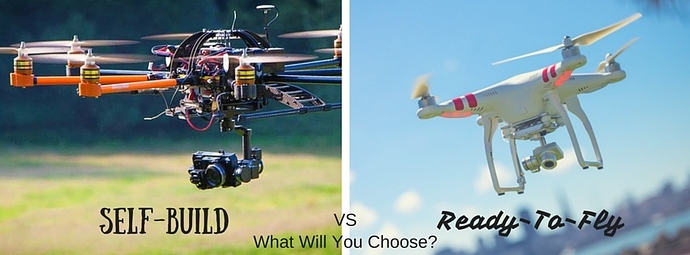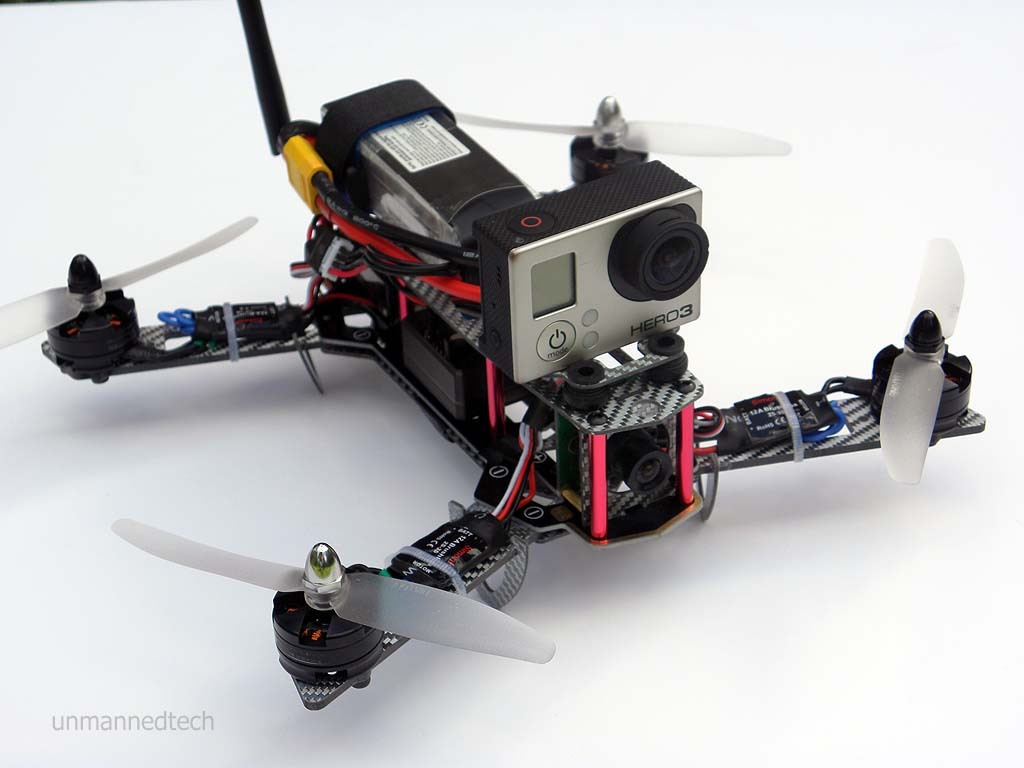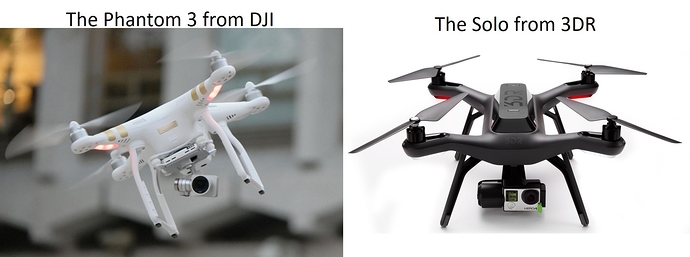Are you new to the field of drones and are wondering if you should go down the self-build route or just get a quadcopter that’s ready to fly straight out of the box? Well, this article goes through some of the pros and cons of each choice to help you decide.
The Self-Built Drone
This is the Silver Blade #37 FPV quadcopter and an example of a self-built drone. If you fancy having a go at building this, we have a comprehensive guide on doing so.
Pros
Firstly, we’ll go through the pros of the self-built drone. I’ll quickly bullet point the main arguments for clarity and then go into a bit more of a discussion. So, we have:
- Cheaper
- Interesting (if you’re in to DIY building)
- Educational (it’s always good to learn a new skill)
- A fulfilling side project in your spare time
- You can customise your drone to fulfill any need/want that you have (for both work and play drones)
- The sense of achievement at the end of the project (seriously, it’s true)
The self-built drone can be a wonderful thing. If you’re new to the field, finding the right kit for you and completing the build may take months, and many frustrating mishaps, but the sense of pride you will feel seeing (and of course flying) your drone will be well worth it. Along the way, you will have to learn at least some of the technicalities behind the equipment you’re using, not least because you will have to choose what you want to use on your drone, and the choices are nowadays quite varied. You will learn how everything works together on your drone and how it all comes together to make the flying machine that you see at the finish. Due to this in-depth knowledge that you will acquire, you can then repair your drone after the inevitable crash (hopefully just a small one) with just a few spare parts. Evidently, building your own drone should also be cheaper than buying a RTF one for obvious reasons; this is always a plus in any context.
On top of these benefits, on the technical side, you can also completely customise your self-built drone to your hearts content. This is extremely useful, particularly when you may be interested in using your drone for various work applications. One of the most common work applications for a drone is in mapping (please see our 5 core applications of drones for more detail), and being able to customise your drone can be invaluable here. You can set your drone to complete a certain flight path over the area you wish to map, taking pictures automatically at whatever interval you have previously set. You can then use other software to combine these pictures into an aerial map of the area. You can also add other sensors to your drone that can detect the health of crops (for example) with a self-built drone. It is possible to purchase RTF drones of this sort, but they generally cost thousands and thousands of pounds whereas you could build your own for a lot less. This is just one example of what a self-built drone can do; if you’ve got an aerial job, the chances are that a drone can be customised to complete it.
Cons
Some of the above points may be considered drawbacks with a self-built drone, depending on what you want from your drone. So, for cons we have:
- It takes time and patience (as mentioned above, it may take many months to complete your build)
- You can’t fly immediately (this can be frustrating)
- Perhaps not as aesthetically pleasing as a RTF drone can be.
One of the perhaps minor points against the self-built drone is its looks. It is likely that your drone will not end up in one neat package with every wire and cable hidden from sight (especially for your first few attempts). The self-built drone can therefore be labeled ‘aesthetically unpleasing’ but it really depends on your point of view. You might quite like the ‘real machine’ look to your drone.
The other main cons that I can see with a self-built drone revolve around the time it takes to build. You can’t simply buy the product, and be flying it the next day. I can definitely see why this would be very frustrating but I am biased toward the self-build; I have always self-built and really feel that the time taken to learn your craft is well worth it. However, I’m moving off the neutral path now so do excuse me. Let’s move on to the Ready-To-Fly option that any beginner should investigate.
The Ready-To-Fly Drone
Above we have two examples of RTF drones from the two main players in this field; DJI and 3D Robotics (3DR). On the left, we have the Phantom 3 from DJI and on the right we have the Solo quadcopter from 3DR.
Pros
Let’s get straight into the pros once again. In a nutshell, we have:
- They’re ready to fly straight out of the box (the clue’s in the name)
- No extra time is needed in learning the technicalities
- No fiddly jobs with wires etc. needed - just unpack and go
- Many cool features
- Aesthetically pleasing
So, the main pro of the RTF drone is obvious; it’s ready to fly with no modifications needed from the owner. In most cases, you simply unpack your drone from the box, plug in the battery, and off you go (after charging the battery). This is pretty awesome, no doubt about it. You can simply get up into the air and start taking some cool aerial footage (which is what most hobby RTF drones are used for).
The most modern RTF drones also come with several cool features that make aerial photography and film-making pretty easy (once you’ve got the hang of the controls). For example, the Phantom 3 from DJI (one of the main manufacturers of these drones) comes with features such as Follow Me, Waypoints and Point of Interest *. These are features in which you simply push a few buttons to tell your drone where to fly, and then you give control over to the drone completely. You are then free to totally focus on controlling your camera and capturing those awesome shots. This is pretty handy as I’m sure you will agree (although keep in mind that you can also program a self-built drone to do these things but this, of course, takes more time).
*Briefly, these features correspond to the following actions. Follow Me is where your drone follows the mobile device that you have on your person - you can capture cool videos of moving cars and sports in this mode. Waypoints is where your drone will fly a pre-determined path set by you. You then don’t have to worry about flying your drone, and can focus on capturing the scene around you. Point-of-Interest is a mode in which you specify a point of interest on your camera. You can then tell your drone to fly around this point of interest smoothly and accurately (you can specify the speed and radius that your drone flies around this point of interest).
Last but not least, the RTF drone may be considered ‘prettier’ than a self-built drone. As you can see from the pictures, they are usually nice and neatly contained within a clean and swish body. They can be thought of, I suppose, as the Apple products of the drone world; stylish and easy to use.
Cons
So, what’s not so good about the RTF option? Even though at first the RTF drone may seem like the ideal choice, there are drawbacks that you need to consider.
- Expensive - you’re probably looking at over £1000 for a quality RTF drone
- Limited uses - the manufacturers have consciously made these drones ‘user friendly’ and this results in limited applications
- Difficult to self-repair
The RTF drone is, of course, expensive; you have to pay for the ease of use with these drones (and all the hi-tech equipment of course). You’re probably going to spend over £1000 for a high-quality RTF drone and this is a pretty big sum. On top of this, the RTF drone actually has limited usage in terms of customisation. This is done intentionally by the manufacturers as their aim is to make a drone that can be used by anybody and is completely user friendly. They therefore limit the use to lower the complexity. You have to decided whether this is something that matters to you and what you might want your drone to be now, or in the future.
In the event of your RTF drone crashing, it is also quite difficult to repair yourself. The reason for this is two-fold; it is actually quite hard to access the equipment to replace and repair in a RTF drone, and you yourself will likely not have the expertise to find the problem and fix it. This will result in an expensive trip to the factory for a repair (or if the crash was really bad, a whole new drone).
The last point I will make in this section is a personal note. I feel that another quite important drawback in a RTF drone is the lack of pride you feel for your drone. This may sound a bit strange but I believe that if you have not spent weeks and perhaps months crafting your drone, you will never have the same sense of pride and achievement when you get it in the air and doing exactly what you designed it for. I believe you also lose a significant portion of the fun if you buy a RTF drone; at least half the fun is in the build for me and in discovering more about the area as a whole.
So, Self-Build or RTF?
As you have probably figured out throughout this article so far, some of these points are not hard fact and just my considered opinion. There are several pros and cons for each options as mentioned above but I think I will always lean toward the self-built drone. You are much freer to customise your drone in any way you want and you will learn all about your drone in the process of building it. This will enable you to modify your drone as you wish in the future. However, don’t get me wrong, the RTF drone is a great thing; it’s easy and simple and great for getting in the air and taking pictures. If you’re looking for a simpler proposition and just want to get flying, then the RTF is probably for you.
Comments or suggestions?
If you have any comments/suggestions on what I’ve written here, please feel free to express them below. Thanks!


